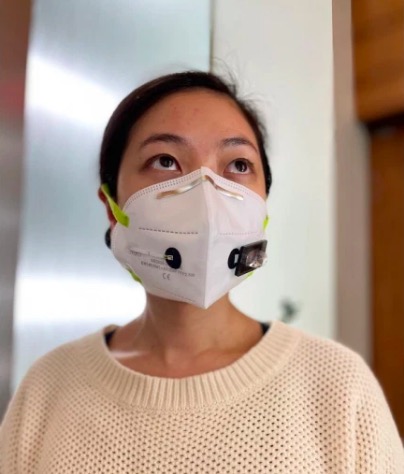
The face mask that can diagnose COVID-19. The wearer pushes a button on the mask that releases a small amount of water into the system, which provides results within 90 minutes. Courtesy of Wyss Institute at Harvard University.
June 30, 2021
(MERCURY NEWS) The face mask that you wear in the future could alert you of a coronavirus diagnosis, thanks to researchers at Harvard University and MIT.
Researchers have created wearable biosensors that can detect the presence of the virus in a person’s breath. These button-activated masks give COVID results within 90 minutes in a simple-to-read format similar to an at-home pregnancy test.
The mask can diagnose COVID at accuracy levels comparable to standard diagnostic tests, according to the researchers from the Wyss Institute for Biologically Inspired Engineering at Harvard University and MIT.
The sky’s the limit for this technology. It can be customized to detect a wide variety of other viruses, bacteria and toxins.
“We have essentially shrunk an entire diagnostic laboratory down into a small, synthetic biology-based sensor that works with any face mask, and combines the high accuracy of PCR tests with the speed and low cost of antigen tests,” said co-first author Peter Nguyen, a research scientist at the Wyss Institute.
“In addition to face masks, our programmable biosensors can be integrated into other garments to provide on-the-go detection of dangerous substances including viruses, bacteria, toxins and chemical agents,” he added.
This tech is the culmination of years of work on what the team calls its wearable freeze-dried cell-free (wFDCF) technology.
The researchers first applied this tech to diagnostics by integrating it into a tool to address the Zika virus outbreak. Then, the COVID-19 pandemic struck.
“We wanted to contribute to the global effort to fight the virus, and we came up with the idea of integrating wFDCF into face masks to detect SARS-CoV-2,” said co-first author Luis Soenksen, a postdoctoral fellow at the Wyss Institute.
While wearing the mask, the user pushes a button on the mask that releases a small amount of water into the system, which provides results within 90 minutes.
When the virus particles are present, the wFDCF system changes the pattern of lines in the readout strip, similar to an at-home pregnancy test.
The team is now searching for manufacturing partners to help mass produce the face mask diagnostic.
This tech can also be integrated into fabric to create clothing for detecting pathogens and environmental toxins.
Co-author Nina Donghia, a staff scientist at the Wyss Institute, said, “This technology could be incorporated into lab coats for scientists working with hazardous materials or pathogens, scrubs for doctors and nurses, or the uniforms of first responders and military personnel who could be exposed to dangerous pathogens or toxins, such as nerve gas.”
